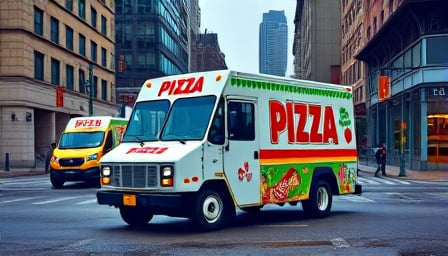Corporate Outlook: Strategic Leadership and Market Momentum at Domino’s Pizza Inc.
Domino’s Pizza Inc. has announced a pivotal leadership transition that underscores its commitment to sustaining accelerated growth amid evolving consumer dynamics. Andrew Andrea will assume the role of Chief Financial Officer (CFO) effective March 2026, succeeding Edward Jamieson, who departs by mutual agreement. Andrea’s pedigree—having steered the financial functions at Marston’s Plc and C&C Group Plc—positions him to guide Domino’s through the next phase of expansion.
Leadership Transition and Financial Stewardship
Andrea’s appointment reflects a broader industry trend wherein multinational food‑service brands are consolidating seasoned finance executives to navigate increasingly complex regulatory landscapes and to capitalize on data‑driven decision making. His experience with multi‑divisional corporations and public market oversight will be instrumental in refining Domino’s capital allocation strategies, optimizing return on investment for franchisee and corporate stores alike, and enhancing transparency for investors.
The CFO succession also aligns with a generational shift in executive teams. With Baby Boomers and Generation X leaders retiring, companies are embracing younger, digitally native talent. This change is expected to accelerate the integration of emerging technologies—such as AI‑powered supply‑chain analytics and dynamic pricing models—into the company’s financial frameworks.
Market Performance Amid Macro Headwinds
Domino’s stock has demonstrated resilience over the past twelve months. An investment of $10,000 made at the end of 2024 has appreciated to over $10,700, yielding a 7.3 % return despite inflationary pressures and supply‑chain disruptions. The company’s market capitalization has surged to $15.3 billion, signaling investor confidence in its operational model.
These figures are particularly noteworthy in the context of broader retail and consumer‑experience shifts. The rise of “grab‑and‑go” lifestyles, fueled by urbanization and the gig‑economy, has amplified demand for convenient, high‑quality food options. Domino’s, with its robust delivery network and digital ordering platforms, is well‑positioned to capture this trend.
Digital Transformation and the Physical Retail Nexus
Domino’s has historically leveraged a hybrid model that blends physical storefronts with a sophisticated digital ecosystem. The company’s forthcoming webcast on October 14 to discuss Q3 2025 earnings will provide a live forum for investors to assess the effectiveness of this dual strategy. Analysts will be keen to evaluate how the integration of mobile ordering, contact‑less pickup, and real‑time inventory management has translated into operational efficiencies and higher average order values.
This convergence of digital and physical retail aligns with broader consumer expectations: shoppers increasingly value seamless omnichannel experiences. By investing in in‑store technology—such as interactive kiosks and AI‑assisted order forecasting—Domino’s can reduce wait times, personalize offers, and drive repeat traffic, thereby increasing lifetime customer value.
Generational Spending Patterns and Lifestyle Trends
The demographic composition of consumers is shifting. Millennials and Generation Z prioritize experiential spending and are more likely to use mobile payment solutions. They also demonstrate a heightened sensitivity to sustainability, seeking brands that commit to responsible sourcing and carbon‑neutral operations. Domino’s initiatives—such as its “green” packaging program and localized supply chains—position the brand favorably among these cohorts.
At the same time, the aging Baby Boomer population continues to contribute significantly to the pizza market’s revenue. This demographic favors the convenience of home delivery, especially during periods of reduced mobility. The company’s robust delivery infrastructure ensures continued relevance across age groups.
Forward‑Looking Market Opportunities
Expansion of Digital Ordering Platforms
Investing in AI‑driven personalization can enhance customer acquisition and retention, particularly among tech‑savvy millennials. A data‑rich approach enables dynamic pricing and targeted promotions that respond to real‑time demand.Experience‑Centric Storefronts
By transforming select corporate restaurants into “experience hubs”—offering live cooking demonstrations, local ingredient showcases, or community events—Domino’s can deepen brand loyalty while generating ancillary revenue streams.Sustainability as a Differentiator
Continued investment in renewable energy for restaurants, biodegradable packaging, and carbon offset programs can attract eco‑conscious consumers and align with regulatory shifts toward environmental accountability.Global Franchisee Support
Enhanced financial tools for franchise partners—such as predictive cash‑flow models and shared‑cost marketing platforms—can streamline operations and improve profitability across international markets.Strategic Partnerships
Collaborations with fintech firms, logistics startups, and health‑tech providers can unlock new customer segments, from subscription meal plans to health‑conscious menu expansions.
Conclusion
Andrew Andrea’s ascension to CFO marks a decisive step for Domino’s Pizza Inc., aligning its financial leadership with the demands of a rapidly digitizing retail environment and a diversifying consumer base. The company’s strong stock performance, combined with its strategic focus on the intersection of digital transformation and physical retail, positions it to capture emerging market opportunities. By continuously adapting to generational spending habits, lifestyle trends, and cultural movements, Domino’s is poised to sustain and accelerate its market leadership in the consumer food sector.
